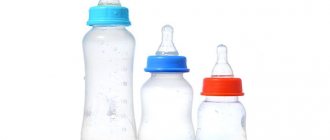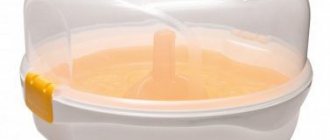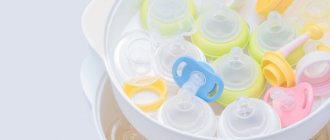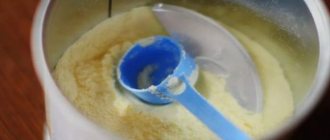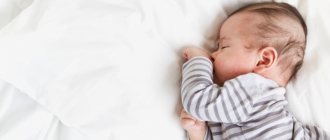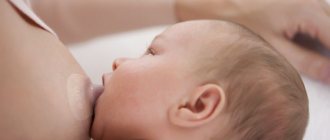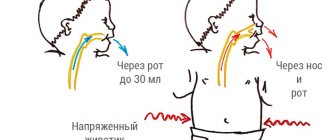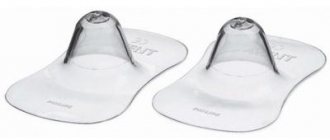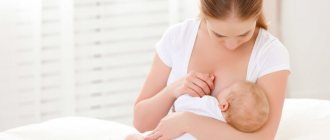What is the secret of how anti-colic bottles work?
Colic is a painful symptom that worries a child in the first months of life.
As a rule, they begin in the newborn period. In premature newborns, colic begins 1 - 2 weeks earlier than in full-term ones.
Colic attacks often persist for up to 3 months. It is not difficult to recognize the painful sensations that bother your baby. Colic begins in the evening and lasts about 3 hours. They appear as suddenly as they disappear.
The mother's diet does not affect colic.
The exact reasons for the development of painful sensations in the baby have not been established. It is likely that colic occurs due to the immaturity of the gastrointestinal tract as a reaction to the colonization of new microflora. Overeating also provokes the development of an attack of colic.
Anti-colic bottles are designed to combat air swallowing during feeding. But this fact is not the reason for the development of an attack of colic. Because the problem is solved after regurgitation. It is more expedient to say that an anti-colic bottle eliminates regurgitation and, thereby, allows the baby to actively gain weight.
The anti-colic mechanism consists of the presence of a special valve, which is installed at the bottom of the silicone nipple. The valve equalizes the pressure inside the bottle with the environment, so there is no vacuum. Air bubbles enter the bottle and are located on the surface of the mixture or milk. They can be seen with the naked eye, thereby assessing the operation of the valve.
A properly working mechanism allows the child not to disrupt the feeding rhythm and eat for a long time without looking up from the bottle. A medium-intensity jet can reduce the risk of air ingestion. That is, the milk should not flow too quickly so that the baby does not disrupt the feeding rhythm and does not choke.
Dr. Brown's
Bottles Dr. Brown's are equipped with perhaps the most inventive anti-colic system:
- At the first stage, air enters through a special hole located in the pacifier holder. There is no contact with breast milk or formula.
- The air then travels through the ventilation system and ends up above the liquid.
- Thanks to positive pressure, the nipple does not stick together, and the baby calmly continues to eat.
Dr. Brown's are unique anti-colic bottles, reviews of which can easily be found on special resources for parents. Those who used such dishes during the period of colic confirm their noticeable reduction.
Among the disadvantages, young mothers note that it is difficult to care for - the package includes five parts and a special brush for washing. In addition, the volume scale is made in transparent letters, which is completely inconvenient, for example, during night feedings. Overall, the anti-colic bottle from Dr. Brown's copes with the task 100%.
Rules for using baby anti-colic bottles
Mothers whose children are mixed-fed are advised to purchase several bottles from different manufacturers. Since only during use can you understand which option is more preferable during feeding. After purchase, it is important to carefully read the product assembly instructions.
An anti-colic bottle may have a different mechanism of action. Therefore, it is important to pay special attention to the recommendations for assembling the bottle. Before use, it is necessary to process the new product either by boiling or by steam sterilization.
Before giving your baby a bottle of food, it is important to check the temperature of the liquid inside. Formula and breast milk should not be heated in the microwave. Because all the beneficial substances a child needs are destroyed. Moreover, the microwave oven heats food unevenly. And if you don’t mix the liquid, you can burn the child.
When to choose an anti-colic bottle
In general, anti-colic bottles are designed for children up to 6 months, when the digestive system is immature. It also makes sense to use such a bottle if the baby constantly swallows air during feeding, there is a risk of frequent regurgitation, which leads to poor weight gain. Therefore, if the “column” position after feeding is not effective, you should take a closer look at anti-colic bottles.
Usually after six months the need for bottles with a special mechanism disappears. Because the reverse reflux of food from the stomach into the esophagus and regurgitation usually goes away. This is also facilitated by the introduction of thicker foods (complementary foods) at this age.
Types of anti-colic bottles
The first question that new parents may face is “Which bottle to choose and what types are there?” Anti-colic bottles differ from each other in shape, material, and the mechanism itself, which reduces the entry of air into the child’s body. The first thing mothers pay attention to is the material the product is made of. Because the bottle is the baby’s first utensil, which means you need to be especially careful when choosing it.
When purchasing a bottle, you need to pay attention to the composition of the product.
The instructions for use should not contain any indications of harmful substances (bisphenol, PVC, etc.). The safest ones to use are glass, plastic and silicone.
Glass
These are the safest and most environmentally friendly products. They can serve for a long time and not lose their original properties. Glass bottles are very convenient to wash and handle. There are no scratches on the glass, in areas where pathogenic bacteria can accumulate.
Despite the large number of advantages, glass bottles also have their disadvantages. The main disadvantage of this type of product is its heavy weight, and glass bottles can easily be broken. Such a dangerous disadvantage often frightens parents, and they prefer bottles made of other materials.
Despite the fact that most manufacturers make bottles from heat-resistant glass, there is still a chance of buying a low-quality product that may burst during sterilization. Also, the mixture and milk in a glass bottle cools down slowly and takes longer to heat up. This fact is controversial for mothers, for some it is positive, for others it is negative. When chips appear on the bottle, it is important to change it immediately.
Plastic
They are the most popular today. They are also safe and very easy to use. Special plastic can be boiled and sterilized, while the bottle does not lose its original appearance. Food in such a container quickly heats up and cools down, reaching room temperature.
But plastic bottles also have disadvantages. Strict control should be established over such bottles, because they quickly become unusable. Constant use leads to cracks and scratches. Such a product is more difficult to treat against harmful bacteria. Plastic can also change color when exposed to certain substances. The appearance of these changes should alert parents and warn them that the product should be disposed of.
Silicone
They are increasingly gaining popularity among mothers today. Manufacturers also choose safe materials during the manufacturing process. These bottles are easy to use. Silicone maintains the desired food temperature for a long time. This type of bottle can change its shape. The baby enjoys holding such a product in his hands and squeezing out food, which develops independent skills.
It takes a little longer to sterilize a silicone product than bottles made from other materials. Silicone imitates a woman's breast by touch, which creates psychological comfort for the child.
How to choose the best anti-colic bottle for your baby?
When purchasing your child’s first “cutlery”, you should show maximum attention and exactingness to the material, quality and type of anti-colic device. So, first things first.
- Material. Carefully read the list of chemical components used in the manufacturing process. Among them there should be no phthalates, bisphenol, PVC (polyvinyl chloride). Glass bottles, polypropylene bottles of matte white color, and polyethersulfone bottles (transparent with a golden tint) are safe. Recently, soft products made from surgical silicone have appeared.
Glass bottles are the most hygienic and safe, the glass does not become cloudy and the scale does not wear off. Disadvantage: the products are quite heavy, they can be accidentally broken, food takes longer to heat up and cool down in them. Lightweight and unbreakable plastic models are best taken for a walk. Disadvantages of plastic: it loses transparency and is stained by juices.
When purchasing, check whether the polypropylene bottle bends - this is a sign of poor quality material. Flexible silicone walls allow you to smoothly regulate the flow of liquid, but at the same time it flows out with the slightest pressure on the bottle. Silicone containers are good for cereals and purees.
- Form. Each manufacturer produces products of the usual cylindrical shape, with a recess in the middle, and curved. According to reviews, “fitted” bottles are the most popular - they are more comfortable to hold for both mother and baby. Curved models are more difficult to wash and the scale is difficult to use.
- Capacity. When choosing, consider the age of the baby. For example, a baby from birth to 2 months needs 125 ml of food, and a one-year-old will need a bottle of at least 250 ml. Don't forget about the scale: there shouldn't be too many divisions, this makes it difficult to prepare mixtures.
- Anti-colic system. The choice is made between simple bottles with an air channel in the nipple and more complex reservoir valve systems. The first options are cheaper (from 200 rubles), but they leak more often. Products of the second group completely eliminate the ingestion of air, have protection against leakage, but are less washable and cost more - 400-800 rubles.
Important to remember! Buy plastic bottles only from well-known manufacturers: their products are properly certified. Cheap products can emit toxic substances: if the bottle emits a strong odor or changes color after boiling or washing, then it is better to throw away such a product.
Bottle shape
In addition to the material, you need to pay attention to the shape of the bottles. Today, the manufacturer is introducing more and more new shapes that differ from the standard cylindrical one. Special bottles are created that have a curved shape or are ergonomic, which are distinguished by narrowing in the middle of the product, so that it is more convenient for the baby to hold the bottle in his hands. But such “conveniences” interfere with proper care of the product. Most bottles have a wide neck. This fact is necessary for careful processing of the bottle.
The most convenient bottles are those without bends and with a wide neck.
Bottles vary in volume and size. Modern products have a scale that makes it easy to determine the volume of liquid needed by the baby. It is very important to pay attention to this, because bottle-fed babies must receive a certain volume of formula, which is calculated taking into account the child’s age.
Small bottles with a volume of 80 - 150 ml are suitable for newborns and premature babies. Children from 4 months already need bottles designed for 250 - 300 ml.
Features of the pacifier
One of the most important factors to consider when choosing a bottle is the nipple itself. It differs in material, shape, and also in the number of holes. Each bottle has its own individual nipple, which is suitable only for it.
Material
The most popular pacifier material is silicone. It lasts for a long time and does not lose its original appearance. But despite the many advantages of a silicone nipple, today there are still more budget-friendly versions of nipples made of rubber and latex. The latter are not recommended for use because the material has a specific smell and taste. Also, the material does not have elastic properties, so after using such nipples the baby may not latch onto the mother’s breast.
Rubber and latex nipples very quickly become unusable due to their soft material, quickly tearing and cracking. If such changes occur, the pacifier should be changed. Also, nipples made from budget materials have the same fluid flow rate, which cannot be adjusted. Silicone nipples have different shapes, which should be selected during use. Newborns should choose nipples with a wide base, which imitate a woman's breast.
When feeding the baby, it is necessary to ensure that the baby grasps the nipple with the base, just as when feeding with mother's milk, the baby must grasp the nipple with the areola.
Form
The shapes of the pacifier have a wide variety of options:
- The standard silicone nipple has a wide base and an elongated top. The top should be on the root of the baby's tongue, and the baby should wrap his lips around the base of the nipple. These nipples are the most popular and comfortable;
- An orthodontic pacifier promotes the correct formation of a child’s bite. It has a specific compressed shape. This nipple anatomically follows the oral cavity. But it must be used correctly and given to the baby, who in turn must suck on it throughout the feeding process in a certain position. Also, for some parents, washing an orthodontic pacifier is often inconvenient;
- The retractable nipple is ideal for mixed-fed babies. Such nipples completely imitate the process of sucking from the mother's breast. Therefore, a nipple pull-up is recommended for bottle-fed babies to reduce the risk of maternal abandonment. The baby must actively suck on such a nipple and grasp it completely in order to receive formula or milk. The retractable nipple lengthens during sucking and takes the correct position in the oral cavity.
Number and diameter of hole
All modern silicone nipples differ in the number of holes on the top of the product. The holes also vary in size. You need to choose the right pacifier taking into account the age of the child, as well as the food that the baby will receive in the future.
For example, it is recommended that newborns take a pacifier with one small hole. Milk or formula will flow out of such a nipple slowly and regularly, which will allow the baby not to choke and eat calmly, without taking in air. As the child grows, parents should pay close attention to the process of feeding from the nipple, since it is already difficult for an older baby to receive food from a small hole in the nipple.
For kefir and thicker foods, special slots have been created in the nipples, and it is even possible to regulate the speed of liquid flow. This important indicator is also worth paying attention to.
The flow speed is felt by the pressure of the fluid flow and is adjusted by digital values from 0 to 5:
- “0” - suitable for babies up to 4 months who are bottle-fed or for children receiving breast milk during the period of weaning. The lowest flow is only suitable for liquid food;
- “1” – recommended for children under 6 months . Also suitable only for liquid foods;
- “2” - the flow is defined as “average” . Suitable for older children from 6 months to one year. This nipple allows various liquids to pass through (tea, water, juices, milk, mixture);
- “3”—fast fluid flow rate. Recommended for children over one year of age and also not suitable for thick foods;
- “4” is a large hole, which is recommended for thick food, as well as for porridge;
- "5" - adjustable flow option . Ideal for children from 3 months. The main advantage of such a flow is that it can be adjusted and changed.
What are they?
Manufacturers produce several types of bottles. They differ in material, capacity, design. But the main criterion is the location of the anti-colic system:
- The valves are located in the upper part, more precisely in the nipple and a special ring.
For the system to work, they must be combined.
- The valve is located at the bottom of the container.
Moms can rest assured that liquid will not leak through it. It begins to function only when sucking.
- With reservoir valve system.
The pressure is regulated by a tube inside the bottle and the top ring. Air comes from the nipple and naturally pushes the liquid out without mixing with it.
Which one is more suitable for the baby can only be found out through experience.
Anti-colic system
And finally, the bottles differ from each other in their anti-colic system. Parents should also try several types of mechanisms to make the final choice. The anti-colic system in all bottles is equally aimed at air circulation so that a vacuum is not created inside.
For this purpose, a special valve has been created, which has different locations:
- at the bottom of the bottle. The removable ventilated bottom provides air ventilation and prevents the child from swallowing air. To create an anti-colic effect, turn the bottom and then special holes open;
- in the nipple itself. This valve location is present on most models of anti-colic bottles. The valve at the base of the nipple also allows air to enter the bottle;
- bottle with built-in anti-colic system. Such products have a higher cost, but are more durable. Also, such bottles are more difficult to wash and handle.
Tommee Tippee
The Tommee Tippee anti-colic bottle is no less popular. The specialists of this brand did not make do with an ordinary valve. The Closer to Nature Anti-Colic Plus bottle series is truly unique.
This system is a combination of a tube and several valves that provide ventilation during feeding. The anti-colic bottle from Tommee Tippee is equipped with a liquid temperature indicator. Pink color means the temperature is higher than the recommended 37 degrees for the baby. The blue color on the temperature sensitive tube indicates that feeding is safe at this time.
Many parents note the unusual shape of Closer to Nature, which provides a slow flow of liquid. The ultra-soft silicone nipple has special transverse rings that imitate the natural movements of the female breast
TOP 8 anti-colic bottles
Parents are advised to pay attention to well-known brands that make feeding bottles. Since proven, reliable brands conduct research, have appropriate certificates and make products from environmentally friendly and safe materials.
You shouldn’t skimp on your baby’s first dishes, because the child’s health depends on it.
The most popular anti-colic bottles that most mothers trust are presented below.
Philips Avent
The English representative of the brand pre-tests the product before releasing it. The Avent line of bottles is represented by Classic and Natural options. All products have a plastic bottle and silicone nipple. The product has a wide neck, which allows for thorough processing. All nipples also have an anti-colic mechanism. But the Natural modification is more recommended for children from the first days of life, since there is a double valve at the base of this nipple.
The Avent bottle for newborns has a small volume - 125 ml. For older children, other product sizes are suitable - 260 and 330 ml. Reviews from mothers about this product are mostly positive. Another undeniable advantage is that the pacifier can be purchased separately for the bottle if the baby has “outgrown” the existing size. The manufacturer offers for purchase a nipple with adjustable fluid flow. The price category is not suitable for everyone and is around 470 rubles per bottle. But there are various kits that are more profitable to buy.
Philips AVENT Anti-colic polypropylene bottle with AirFree™ valve SCF813/14, 260 ml from 1 month.
Dr. Brown's
The American brand is also a reliable, well-known and popular brand. Anti-colic bottles from this company are produced with a built-in system. It consists of a sleeve, a funnel and a tube. This reservoir allows air inside the bottle and prevents it from mixing with the liquid. The air bubbles gradually displace the liquid, which prevents the bubbles from entering the child's gastrointestinal tract.
The bottles are made of plastic and the nipples are made of silicone. The shape can be different (cylindrical and ergonomic). It is also worth noting that the neck can also be either wide or narrow. The volume that can be found on the market is 120 and 240 ml. The smaller volume is suitable for newborns and premature babies. Most mothers are satisfied with this product, but some are unhappy with the fact that washing the bottle and reservoir is often difficult.
The Doctor Brown bottle also has a high price category. A set of a 120 ml bottle and a special brush for washing the anti-colic system will cost 450 rubles. The price depends on the area and the store where the product is sold.
Dr. Brown's Polypropylene bottle with narrow neck Options, 250 ml
Medela Calma
The Swiss manufacturer presents a special silicone smart nipple, which is more suitable for children on mixed and breastfeeding. This model completely imitates the process of sucking milk from the mother's breast. But the child needs to adapt to such a nipple and actively perform the act of sucking.
Among the negative reviews, it is worth noting that mothers do not always cope with the complex system of arranging a bottle, and some children also refuse it. Otherwise, the pacifier meets all modern requirements and is made of high-quality and safe plastic. The price varies from 700 to 1100 rubles.
Medela Bottle with Calma smart nipple 150 ml from birth
Canpol Babies
Polish products, which belong to the budget version of anti-colic bottles. This nipple is an analogue of the Philips Avent Natural. All bottles have a plastic composition and a silicone nipple, the safety of which cannot be doubted. All products have a wide neck and anti-colic valve. For newborns there is a small volume of 120 ml.
Most mothers are satisfied, but some note the stiffness of the nipple and a weak anti-colic effect. The price is an advantage of this bottle and ranges from 270 to 400 rubles.
Canpol Babies Anti-colic bottle Haberman 260 ml from birth
Pigeon
The Japanese manufacturer presents to our attention both plastic and glass anti-colic bottles. These bottles are among the leaders used for children from birth. High quality is the advantage of this product.
The silicone nipple is very pleasant to the touch, but the baby needs to make a lot of effort to get milk. Therefore, it is an ideal option for children who are mixed and breastfed.
The nipple has a small hole and a valve that creates an anti-colic mechanism. The bottle can retain its original appearance for a long time. Tempered glass does not crack with constant processing. The price depends on the material and varies from 450 to 900 rubles.
Pigeon Peristaltic Plus bottle with wide neck PP, 240 ml from 3 months.
NUK
The German quality of products is also beyond doubt. The manufacturer produces bottles made of glass and plastic. Also offers a wide variety of nipples. But a glass bottle made of impact-resistant, tempered glass with an anti-colic, orthodontic nipple requires special attention. The product can be used from the first days of life.
The silicone nipple contains a slow flow of liquid and a special valve that prevents the swallowing of air. This bottle material withstands all bottle processing processes. Most mothers claim that glass is so strong that it is not so easy to break. The price varies from 720 to 1000 rubles.
NUK First Choice Plus bottle made of polypropylene with latex teat, 150 ml from birth
Tommee Tippee
The English brand offers bottles with a unique anti-colic system. It consists of tubes and valves located along the length of the tube. The bottle is made of safe plastic, and the nipple is made of durable silicone. The product has a wide neck.
The main feature of this anti-colic bottle is that the tube inside the product has an indicator that shows the temperature of the food. Blue color indicates that the liquid needs to be heated, and red, on the contrary, needs to be cooled. For newborns, the optimal volume is 150 ml. The price is 820 - 850 rubles.
Tommee Tippee Closer to Nature feeding bottle with anti-colic valve, 42252175, blue, 260 ml, 2 pcs.
Chicco
Bottles from an Italian manufacturer are characterized by the presence of an anti-colic mechanism located at the base of the silicone nipple. The bottle material can be either glass or plastic. Most mothers are satisfied with using these bottles. The estimated cost depends on the material of the product and ranges from 350 to 730 rubles.
Chicco Bottle with inclined nipple Natural Feeling, 150 ml from birth
Natural Series
Parents who choose British brand products for their children note several advantages:
- Versatility. All Avent products are compatible with each other and also have a wide neck, making it easy to add the mixture to the bottle.
- Safety. No harmful substances are used in the manufacture of dishes.
- Comfort. The bottle is easy to disassemble, wash and assemble - even a young dad can cope with this simple task.
The Natural series from Avent has gained the most popularity. Many pediatricians warn that once bottle feeding begins, a baby may stop latching on. It is for this reason that the company's designers developed a wide pacifier. Its shape follows the female breast, so combining natural and bottle feeding will be quite simple.
The lower part of the nipple consists of special “petals” that make it more flexible and soft, providing comfort for the baby. In addition, the container itself fits comfortably in your hand.
Anti-colic bottle care
Caring for your baby's bottles requires special attention. Dishes must be kept clean and dry. It is also important to constantly monitor bottles for cracks and scratches. Because pathogenic microorganisms accumulate in large numbers in such defects. After purchase, parents should read the instructions for use and assembly of the product. Before use, it is important to thoroughly clean the bottle and boil it.
After eating, it is recommended to wash the bottle using baby detergent and a special brush or sponge, which are often included with the product. Before each use, the bottle should be sterilized in a sterilizer. Some bottles are dishwasher safe. But these instructions can only be found in the instructions for use that come with the bottle in the package.
It is important to monitor the integrity of the bottle and the nipple itself. If the bottle has lost its appearance, the ml scale has become worn out, cracks, chips, or scratches have appeared, then it is necessary to replace the bottle with a new one.
It is also important to monitor the condition of the nipple and the valve itself. If defects are formed, the anti-colic system may fail. For hygienic purposes, it is recommended to change the pacifier regularly (every 3 months). Clean, dry containers should be stored at room temperature with the cap closed.
